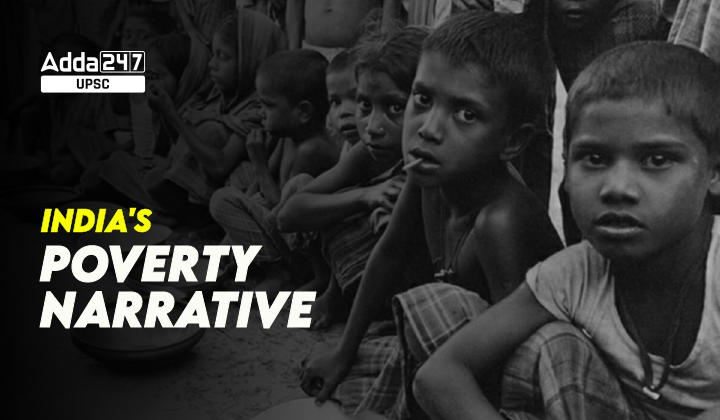Table of Contents
NITI Aayog’s B.V.R. Subrahmanyam recently made a striking claim that less than 5% of Indians currently live below the poverty line, drawing from the Household Consumption Expenditure Survey (HCES) for 2022-23. This assertion posits a significant decline in poverty levels, suggesting a noteworthy shift in India’s socio-economic landscape.
The Poverty Line Criterion
The poverty line serves as a critical benchmark for gauging economic well-being. In India, this threshold varies between rural and urban regions, with current figures hovering around ₹1,500 for rural areas and ₹1,800 for urban locales, as per the Tendulkar poverty line. This metric, however, has sparked debates on its adequacy and the pressing need for its revision to more accurately reflect contemporary economic realities.
National Sample Survey Organisation (NSSO) data: Shows a 3% annual increase in real consumption.
Counterpoint: This growth might not be evenly distributed.
-
- Focus on top earners: Studies suggest a significant rise in consumption for the top 10-15% of earners.
- Stagnant demand for essential goods: Indicators like sales of mass consumption goods (FMCG) and two-wheelers (a common mode of transport) haven’t shown significant growth. This suggests a lack of improvement in purchasing power for a large portion of the population.
Reliance on public investment
-
- Private investment: Lacks revival, potentially due to stagnant mass consumption.
- Government spending: Fills the gap through increased public capital expenditure to drive GDP growth.
A Closer Examination
A noteworthy decline from 12.5% in 2011-12 to a mere 2% in 2022-23, advocating for an upward revision of the poverty line to better capture the essence of extreme poverty and its eradication.
Lack of Official Poverty Line: Currently, India lacks a definitive, government-declared income-based poverty line.
Alternative Measures
-
- The Tendulkar Line: This measure is used unofficially and is based on minimum calorie intake. However, critics argue it lacks a strong conceptual foundation.
- World Bank’s $2.15/day: This international poverty line translates to very low extreme poverty rates in India.
Data Discrepancies:
-
- The recent survey indicates a 2.5x increase in consumption expenditure since 2011-12.
- Critics argue that income data doesn’t reflect a similar rise, suggesting a potential gap between income and spending.
Consumption Increase: He acknowledges a 40% real increase in per capita consumption expenditure over 11 years.
Supporting Data:
-
- The Periodic Labour Force Survey (PLFS) shows a 3.2% annual increase in real wages for agricultural workers since 2011.
- Tax data indicate a steady rise in salaried worker wages since 2011.
In essence:
- The text identifies the absence of an official poverty line and the limitations of current methods.
- It highlights a potential discrepancy between rising consumption and income data.
- Data suggests an increase in real wages, potentially explaining the rise in consumption.
- It’s crucial to consider factors like:
- Borrowing or debt accumulation to maintain consumption levels.
- Changes like work and the informal sector’s contribution.
Arguments Supporting Real Wage Growth
- Increased consumption: The speaker highlights a 40% rise in per capita real consumption over 11 years, indicating improved living standards.
- Wage data: Evidence is presented from the PLFS showing a 3.2% annual increase in real wages for agricultural workers since 2011 and robust growth in salaried worker wages based on tax data.
Arguments against Real Wage Growth
- Contradicting studies: The speaker acknowledges opposing studies suggesting a meager 1% annual increase in real wages since 2017, with a decline for construction workers.
- Misleading employment data: The claimed rise in employment (PLFS 2022-23) is attributed to a surge in unpaid family workers, not actual paid jobs.
Low female labor participation: The data reveals a significant portion of women working unpaid (37.5% in 2022-23) compared to paid employment (13%).
The Case for Raising the Poverty Line
The discussion underscores a consensus on the necessity to elevate the poverty threshold. Applying the World Bank’s lower-middle-income criterion reveals a broader spectrum of poverty at 25% in rural areas and 11% in urban zones, culminating in an overall rate of 21%. This disparity calls for a recalibrated approach to poverty measurement, ensuring a more inclusive and realistic assessment of economic hardship.
Conclusion: Balancing Growth with Nutritional Security
The discussions surrounding India’s economic growth, consumption patterns, and the reliability of data shed light on the complex interplay between economic development and equitable access to resources. As India strives for economic progress, it is imperative to ensure that growth is inclusive, nutritional well-being is prioritized, and the integrity of statistical data is maintained to inform effective policymaking.



 TSPSC Group 1 Question Paper 2024, Downl...
TSPSC Group 1 Question Paper 2024, Downl...
 TSPSC Group 1 Answer key 2024 Out, Downl...
TSPSC Group 1 Answer key 2024 Out, Downl...
 UPSC Prelims 2024 Question Paper, Downlo...
UPSC Prelims 2024 Question Paper, Downlo...
